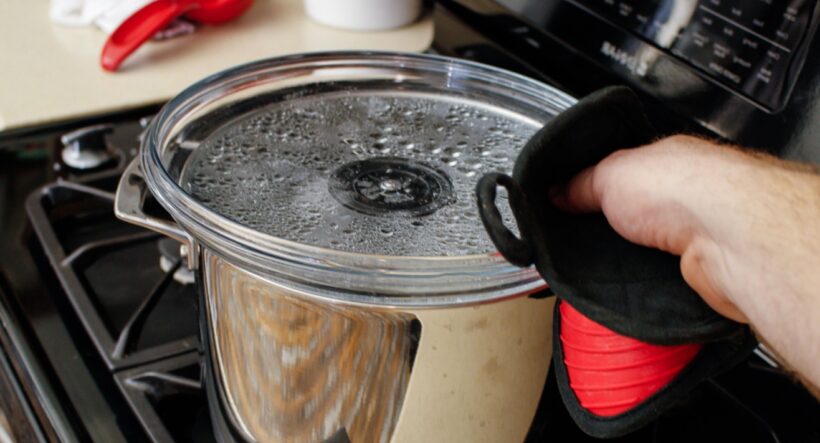6 Easy steps to make distilled water at home
Water is the source of life. People use water in their everyday activities, such as taking a shower, washing dishes, doing laundry, and of course, hydrating themselves. However, normal water contains a variety of minerals and contaminants. In that case, distilled water is the one preferred, as it is the cleanest and purest water one can drink. This article will explain what distilled water is, and how to easily have your very own distilled water at home.
What is distilled water?
Distilled water is the water that has been purified by being boiled into steam, then condensed back into liquid in a separate container. By doing so, the impurities that were in the water are extracted out in the container, making it completely clean and free of minerals and other contaminants.
Are boiled water and distilled water the same?
One misconception that people may have is that boiled water is the same as distilled water, which is not true. Boiled water is just water with its temperature increased until it reaches its boiling point. This kills bacteria that can make a person sick, but still has its minerals. Distilled water is water that has been stripped of all impurities, including minerals, toxins, and microorganisms.
Common uses for distilled water
Because distilled water is free of contaminants and minerals, it’s often used in cars and household appliances. Here are a few common uses:
- Car cooling systems
- Steam irons (distilled water prevents the inside of steam irons from getting clogged up with minerals.)
- Humidifier (distilled water has no minerals and other particles to clog up the machine)
- Aquariums (but mineral supplements should also be added to the fish food)
- Watering plants
- Preserving fruits and vegetable (distilled water won’t alter the taste and the color of the preserved food)
- Cleaning wounds (helps prevent infection)
- Laboratory experiments
- Continuous positive airway pressure (CPAP) machines
Is distilled water safe for human consumption?
As we all know, humans need to drink water to live, but water isn’t always safe for consumption. In some places, the water can contain a variety of substances that can be extremely harmful to humans when consumed, such as heavy metals, pesticides, or bacteria and viral pathogens. Especially in the area where the water is pumped directly from wells, rivers, lakes, and underground reservoirs to the faucet or municipal water supplies. This is the reason why distilling your water at home could help when you need to be sure that the water you drink will not harm your health.
Distilled water is similar to rainwater, as both of them are produced by similar processes of evaporation and condensation. Rainwater is commonly used as drinking water in many countries and is generally considered to be safe. However, distilled water is generally much cleaner than rainwater since it is collected immediately while rainwater may collect some gases and particles on the way down.
Even though distilled water is completely safe to drink, it is flat and has no taste because the distillation process removes important minerals such as calcium, magnesium, and sodium from it, and the minerals are what give tap water its taste that we are so familiar with.
How to Distill Water at Home
While distilled water isn’t excessively expensive, it can sometimes be hard to obtain. So instead of buying one, you can create it yourself using a few household materials, which are;
- A large aluminum or stainless steel pot
- A rounded lid for the pot
- Ice cubes (very cold water or ice packs could work too)
- A fire-proof glass or metal bowl
- Tap water (or any water that you want to purify)
- Oven mitts (or other things that can protect your hands from the heat)
Here are the step-by-step directions for making your own distilled water in just under an hour.
- Step one: Fill a large aluminum or stainless steel pot with tap water until about ⅓ or half full and put it on the stove. (Do not turn the stove on yet)
- Step two: Place a fire-proof glass or metal bowl on the water inside the pot so that it is floating on the surface of the water.
- Step three: Turn the pot’s lid upside down and place it on top of the pot, then fill that pot lid with ice cubes.
- Step four: Turn on the stove then wait until the water in the pot starts boiling, then let it boil for about 40 – 50 minutes. The boiling water will become steam and hit the cold lid of the pot then be cooled down to become water again. Some of that water will drip into the glass bowl which becomes the distilled water.
- Step five: Check and make sure that the distilled water in the bowl inside the pot won’t come to a boil too. If it does, lower the temperature. Keep adding ice cubes on the lid when it melts to keep it cool until you’ve collected enough distilled water.
- Step six: Turn off the stove and carefully remove the lid by using oven mitts to protect your hands. Be careful of the excess of hot or warm water that accumulates on the lid and try to prevent it from spilling over on the stove or counters. Take the bowl of distilled water out of the pot and leave it to cool down so you can store it in bottles for future use.
And there you go! That’s how you make distilled water at home. You can also purchase a reverse osmosis device, but a good one won’t come cheap. On that note, have fun making your own distilled water.

No Comments